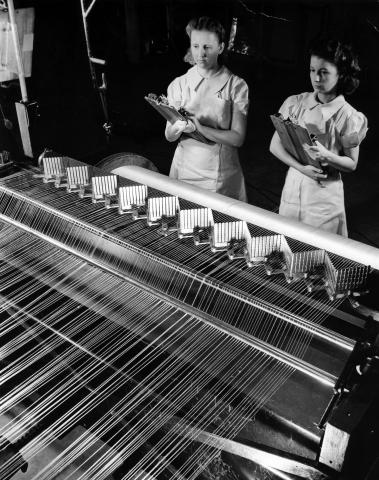
Today's #WorkerWednesday image shows DuPont employees performing a check inspection of Cordura rayon at Rayon Department of E.I du Pont Nemours & Company's Spruance plant in Richmond, Virginia. Their work was documented by commercial photographer Robert Yarnall Richie (1908-1984) around 1945.
A note attached to the photograph reads:
A recent development in the textile field that is growing in importance is Cordura rayon. This rayon yarn was made expressly for the manufacturing of cords for bus, truck and passenger car tires. Because of its high strength and its ability to maintain this high strength at elevated temperatures, bus and truck tires with a cord made of this rayon yarn give double and even triple the mileage obtained with ordinary tires, and what is more important, reduce the hazard associated with blowouts at high speeds. Of special interest, particularly at this time, is a recent statement issued by one of the Country's Air Transport Lines that they are adopting rayon as the materials for the tires of its fleet of airlines.
Cordura rayon with its high strength enables the tire manufactures to build airplane tires anywhere from 10 to 20 pounds lighter than those formerly used. This saving in tire load means the airlines are able to increase their gasoline capacity or payload. It has also appeared in women's kitted underwear and men's hosiery and has also been used in making window curtains of the nylon type and also of an organdy type. It has appeared also in a marquisette dress fabric. Cordura rayon is made by the viscose process and was developed by DuPont chemists ....
This image is from Hagley Library's DuPont Company Product Information Collection (Accession 1972.371). In 1952, the DuPont Company organized a Product Information section within the Public Relations Department. Its main purpose was to create news releases accompanied by photographs that would be run editorially by trade journals and newspapers to create inexpensive publicity and indirect advertising.
To be used, the news releases had to include interesting information about a DuPont product, its development, manufacture, or applications. They could not be direct commercial promotions of a product itself as that would be the work of the Advertising Department. Product Information photographs and their news releases told the reader what DuPont did, why it was important, and sometimes, how it was done.
This collection has not been digitized in its entirety, but a selection of materials from it, mostly photographs taken from the 1930s through the 1950s, are available to view in our Digital Archive. Click here to take a look!

